Aloe Veras are famous for their attractive look and healing properties. They are native to the arid regions of Africa and the Arabian Peninsula. Aloes are found in various varieties and are great plants for beginners.
Aloe vera plant requires bright natural light for 4-6 hours, watering once every 2-3 weeks, occasional feeding, well-drained soil, warm temperature, low humidity, and repotting once in 1-2 years. Providing them with appropriate conditions will help them thrive.
However, there is a lot more to know.
If you want the right care tips for an Aloe Vera plant, this article has everything regarding the subject. You will find all information about their requirements for their good health in the long term.
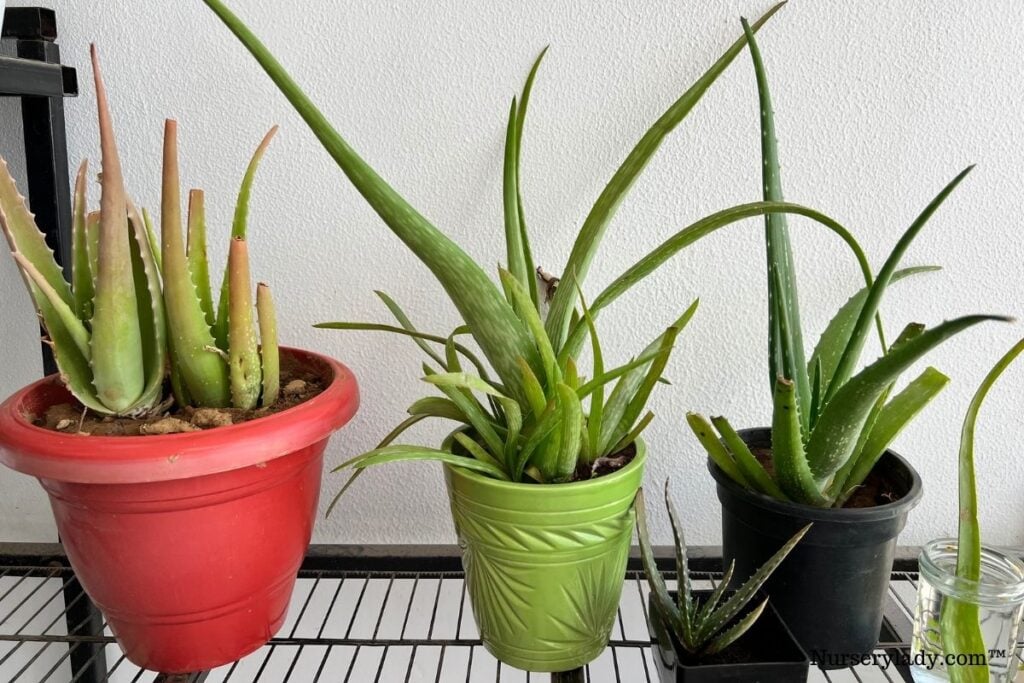
14 care tips for the Aloe Vera plant
Aloe Veras are low-maintenance plants and need less attention.
They are good for beginners as they can thrive in neglect.
Despite this feature, you must follow some basic needs without which the plant won’t survive.
So, let’s dive into it.
1. The best time to grow Aloe Vera is during spring.
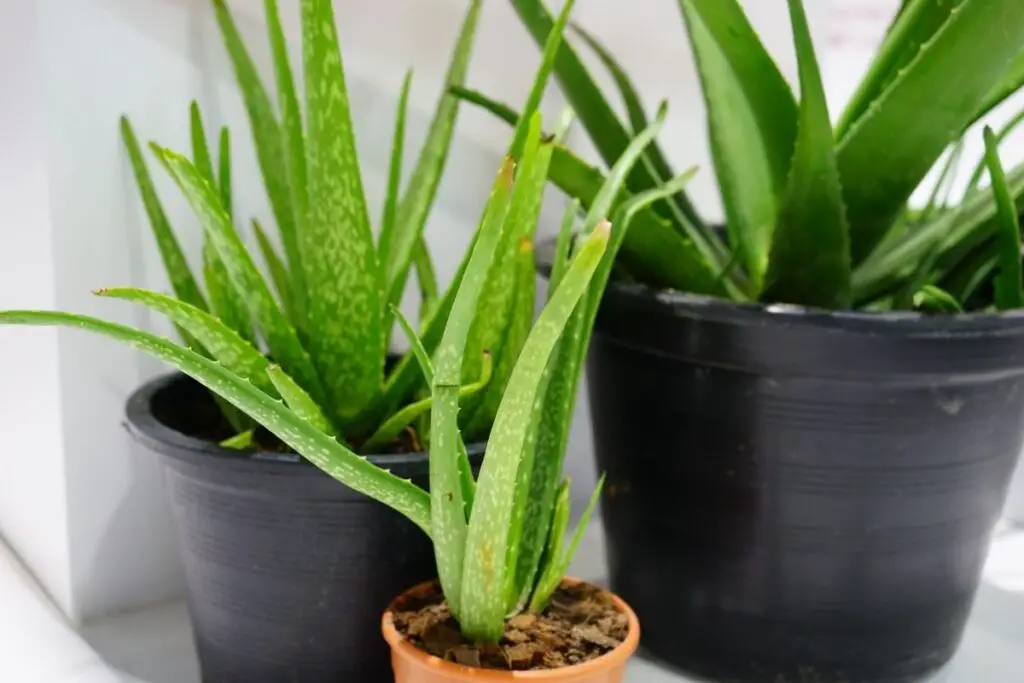
Aloe Veras grow best when planted in the spring season.
As it is their growing season, they will grow well and fight shocks if they get any.
Since they love warm temperatures, summer is also considered their growing season.
So, you can also grow Aloe Vera in the summers.
But, there is an exception.
If the temperature rises above 80-90°F, the plant will go dormant.
They will stop growing further to rest.
If you plant Aloe Veras during dormancy, they won’t show any growth.
If you still grow them, they will be unable to fight shocks.
Since winter is their enemy, it is better not to grow Aloe Vera in winters.
The Aloes will slow down their growth in winters and won’t grow much well.
Also read: How Fast Does An Aloe Vera Plant Grow? (+How To Grow Faster)
2. You can grow Aloes indoors and outdoors with the right care and conditions.
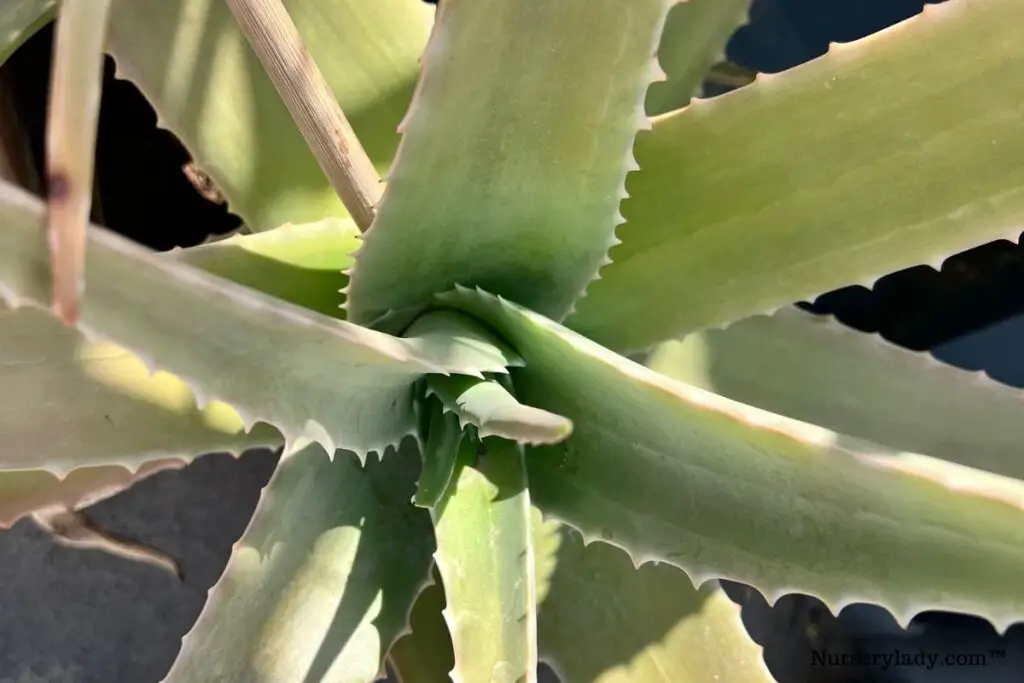
Aloes can be grown both indoors and outdoors.
Provide them with their requirements on time.
Aloes will never struggle for anything.
The only problem indoors could be sunlight.
The Aloes love sunlight and won’t receive the same sunlight as the outdoor Aloes.
But don’t worry, I will suggest the right location for indoor and outdoor Aloes where they receive sufficient sunlight.
Also read: Is Aloe Vera Indoor Or Outdoor Plant? (+Care Difference)
3. Location is important.
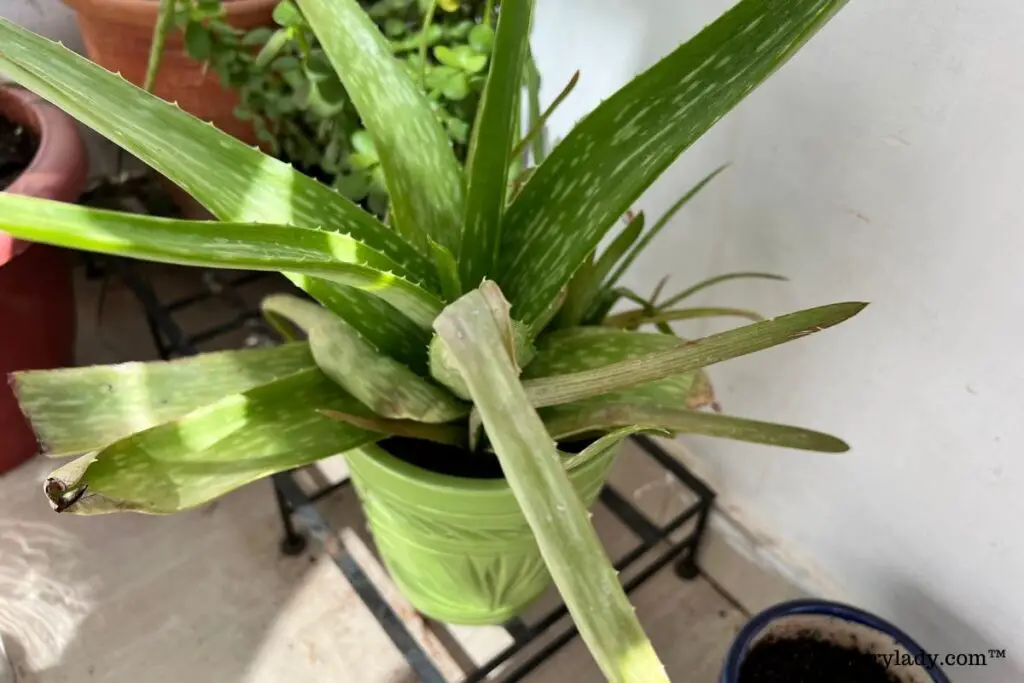
For growing Aloe Veras successfully, the location where they stay is very important.
Location determines the amount of light, soil type, average temperature, and humidity.
Whether you grow Aloes indoors or outdoors, you must ensure they obtain enough sunlight, well-drained soil, warm temperature, and low humidity.
It should also be away from pets and children due to its toxicity.
Find an isolated place in your garden where pets don’t loiter.
For indoors, keep them somewhere up.
But ensure they get all other requirements evenly.
Also read: Where Should Aloe Vera Plant Be Kept? (Ideal Spot+Points To Remember)
Looking for gardening supplies? We have tested 100's of products before recommending them to you guys. Check out our best pick below:
| Image | Gardening Supplies | Best Price? |
|---|---|---|
 Top
Top Top
Top | Raised Garden Bed Kit | Check On Amazon |
 | XLUX Soil Moisture Meter, Plant Water Monitor, Soil Hygrometer Sensor for Gardening, Farming, Indoor and Outdoor Plants, No Batteries Required | No Results |
 Top
Top Top
Top | 82 Pcs Garden Tools Set and Extra Succulent Tools Set | Check On Amazon |
 | Joeys Garden Expandable Garden Hose with 8 Function Hose Nozzle, Lightweight Anti-Kink Flexible Garden Hoses, Extra Strength Fabric with Double Latex Core, (50 FT, Black) | No Results |
 Top
Top Top
Top | Dual Chamber Compost Tumbler | Check On Amazon |
 Top
Top Top
Top | Sunnyglade Plant Stakes | Check On Amazon |
 Top
Top Top
Top | Organic Cold Pressed Neem Seed Oil | Check On Amazon |
 Top
Top Top
Top | Mighty Mint Gallon :-Insect and Pest Control Peppermint Oil | Check On Amazon |
 Top
Top Top
Top | Scotts DiseaseEx Lawn Fungicide | Check On Amazon |
 Top
Top Top
Top | Jacks Classic 20-20-20 All Purpose Fertilizer | Check On Amazon |
 Top
Top Top
Top | 30,000 Seeds Pollinator Attracting Wildflower Mixture | Check On Amazon |
 Top
Top Top
Top | Survival Vegetable Seeds Garden Kit-Over 16,000 Seeds | Check On Amazon |
4. Aloes should receive at least 4-6 hours of sunlight daily
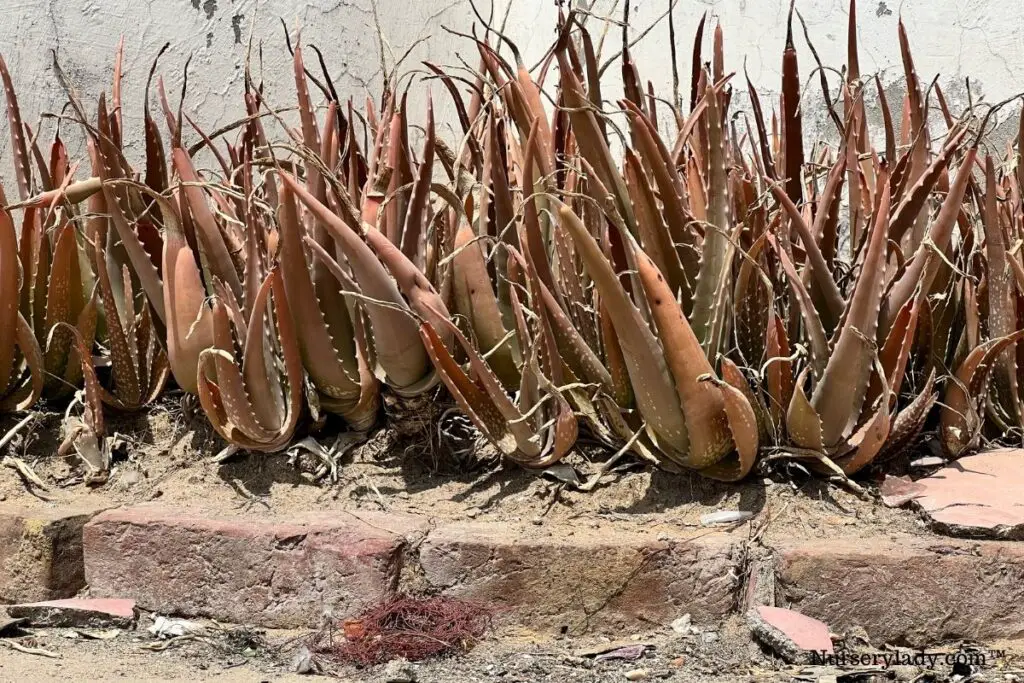
Belonging to desert areas, Aloes love full sun daily for healthy growth.
The Aloe Veras must receive daily 4-6 hours of sunlight.
For planting them outdoors, select the sunniest spot in your garden.
Plant the Aloes at that location. Generally, the south or west direction will receive lots of sunlight.
If your Aloes are getting harsh sunlight, common in summers, fix on shading nets to protect them from sunburns.
For growing Aloe Vera indoors, place them near a south or west-facing window.
But, since these directions receive intense sunlight, you can shift them a few feet back or fix on transparent curtains to filter the light.
However, this direction is good in winters as the sun level is lower in the cold.
During the summers, keep your plant near the north or east-facing window.
It will give your Aloes sufficient, less intense sunlight.
The best condition would be direct morning sun and some shade to protect from the harsh mid-day and afternoon sun.
For indoor Aloes, you can use artificial lights.
But still, at least 2-3 hours of natural light is essential for big Aloes.
Also read: What Kind Of Light For Aloe Vera Plants? (Full sun, Shade, Or Partial Light?)
5. The right container will also keep the Aloes healthy
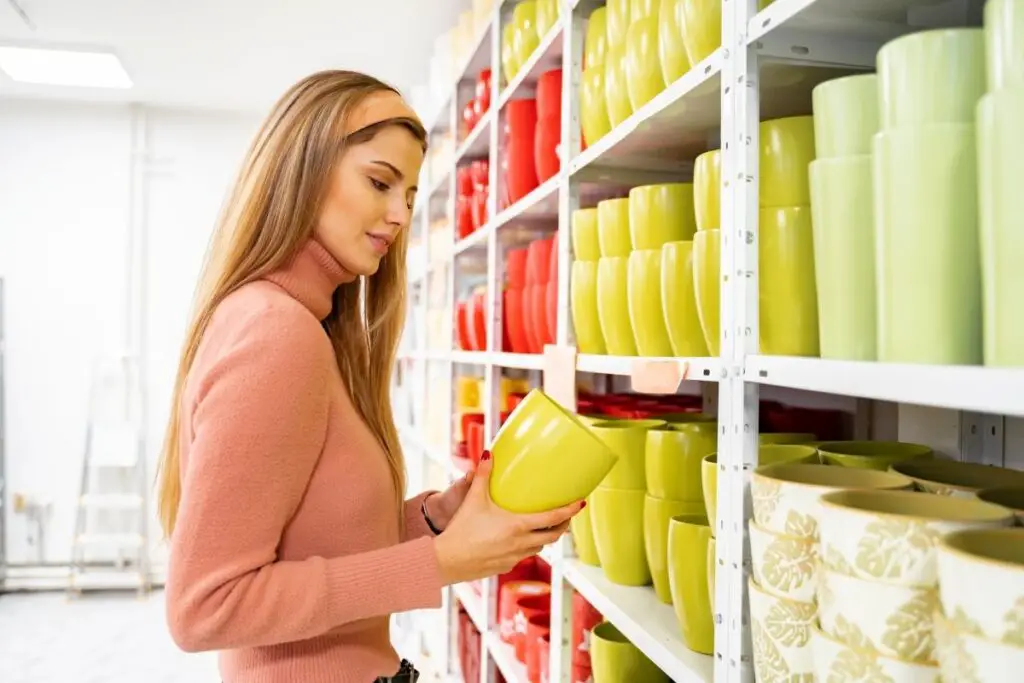
When it comes to the container, drainage, size, and quality must be considered.
Firstly, the planter must have drainage holes to drain the excess water.
It will also help fast dry the soil as airflow can enter through the drainage holes.
Without drainage holes, the water remains stagnant in the soil and results in overwatering and root rot.
Secondly, the size should be appropriate.
If you use a small container, the plant will suffer root-bound.
The water will immediately flow out of the drainage holes, and the plant will be dehydrated.
The drainage holes will get blocked when the roots grow out from the potholes, and thus, the water you provide fails to drain out.
The soil will also hold moisture if the roots become too compact.
When you use an oversized container, it requires a lot of soil which takes forever to dry, thus resulting in overwatering.
Use a container that is 1/3rd bigger than the plant’s roots.
While repotting, take a container 1-2 inches bigger than the old one.
The depth should be only 2-4 inches and not more than that because
Aloes don’t have very deep roots.
Thirdly, the quality of the container can help in drainage.
To keep your Aloe Vera dry most of the time, use terracotta pots.
It is made of porous material and can wick away moisture quickly.
However, if you have excelled in watering, you can use any pot, like plastics or ceramics.
Also read: What Pot Is Best For Aloe Vera Plant? (Pot Type, Size & More)
6. Water the Aloe Veras once every 2-3 weeks.
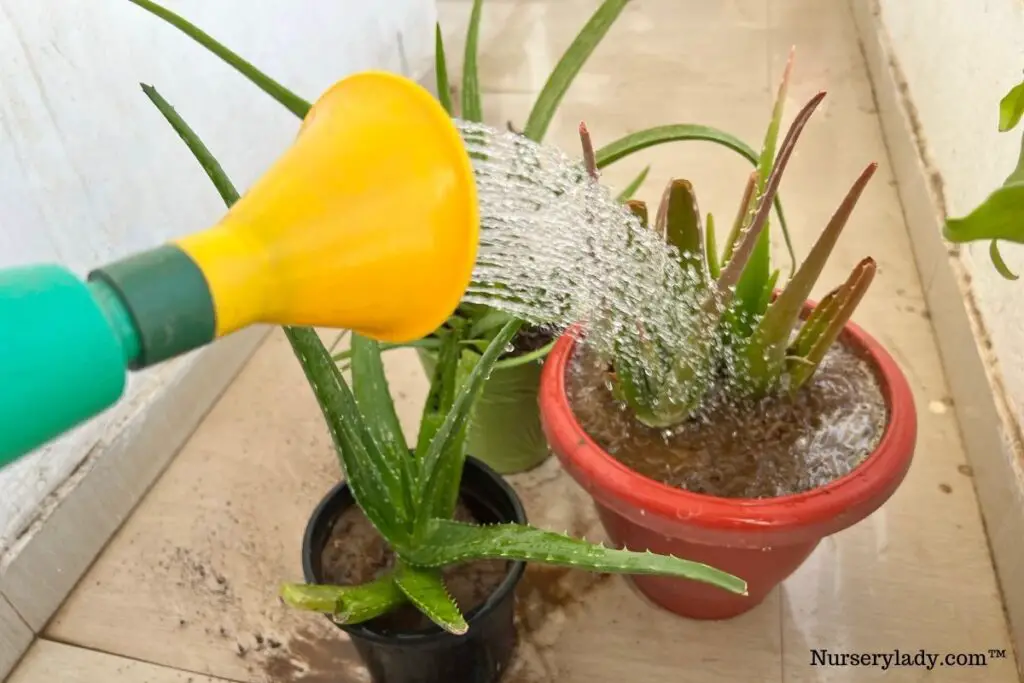
Aloes belong to arid regions, and thus, don’t wet them with frequent watering.
Moreover, they can store water in their leaves.
Generally, Aloes should be watered once every 2-3 weeks in their growing months.
The frequency will change depending on the season, soil, plant size, and maturity.
During the summers, since the soil dries faster due to the weather, water them once every 1-2 weeks.
But reduce the frequency when the temperature crosses 80-90°F because they will go dormant.
In the winters, the Aloes grow slowly.
Additionally, the sun hours and evaporation rate are less.
These two reduce the drying speed of the soil.
So, scale back watering in winters and keep the growing medium almost dry.
A big mature plant doesn’t need frequent watering.
But they need more water for storage and hydration.
Since the Aloes are still growing, they need frequent watering in small amounts.
The best way to understand the watering needs of Aloes is to check the soil moisture.
The plant is ready to take water when the soil’s top 2-3 inches is dry.
If you are a beginner, follow this method.
Once you master knowing their watering needs, you can understand and follow up a certain routine accordingly.
Also read: How To Water Aloe Vera Plant? (How often, Summer, Winter)
7. Aloe Vera grows best if planted in well-drained soil
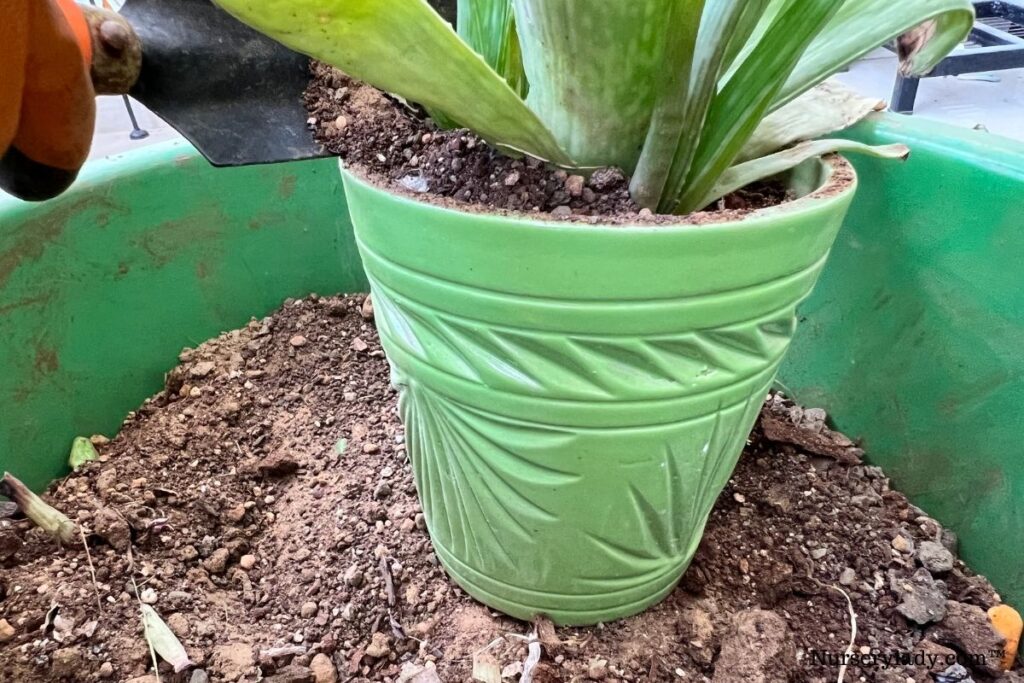
In their native land, Aloes grow in sandy soil that doesn’t hold moisture for a long time.
They receive all the requirements naturally in their natural habitat, whether drainage, pH level, or nutrition.
While growing them in your garden or house, you must mimic their growing environment.
Besides drainage, the pH level should be between 5.5 and 8.5.
Though they can survive in poor soil, slight nutrition can stimulate their growth.
Use commercial cactus and succulent potting mix for potted Aloes because it is designed for all the succulents.
To make soil mixes yourself, try the following:
- 1 part loam, 1 part sand, 1 part perlite, 1 part pumice, and 1 handful of pine bark fines
Pine bark fines ensure the pH level. Perlite, pumice, and sand help in drainage and retention.
- 1 part potting soil, 1 part coarse sand, 1 part perlite, and 1 part of half part compost
- 3 parts potting soil, 2 parts pumice, and 1 part peat.
Peat ensures moisture retention and acidic level of the soil. Due to its moisture-retentive feature, use peat in small quantities.
- Equal parts of garden soil, coarse sand, and peat moss
- 2 parts coarse sand or perlite, 1 part coco coir or sphagnum moss, and 1 part vermicompost
- Sphagnum moss helps in drainage, retention, and neutral pH levels.
Using these soil mixes will ensure the plant’s drainage, nutrition, and pH level.
You can use them for both potted and in-ground Aloe Veras.
Focus more on the drainage.
Also read: What Type Of Soil For Aloe Vera Plant? (+Ideal Soil Mix)
8. Though Aloes are not heavy-feeders, you can fertilize them occasionally.
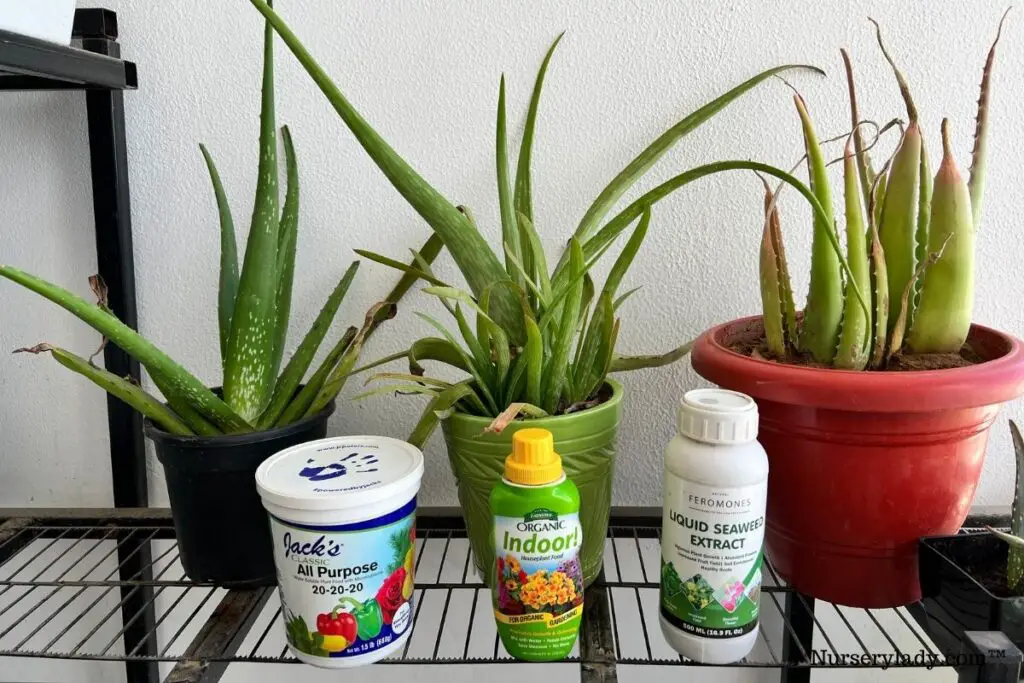
Aloe Veras grow seamlessly in poorly nutritious soil in their native land.
It is because they receive everything naturally from Mother Nature.
But while growing them in your garden or home, you have to feed them besides their requirements to stimulate their growth.
Fertilize Aloes only during their growing months, which are spring and summer.
In summer, feed them only if the temperature remains within 75°F.
Avoid if it has crossed 80-90°F.
Always dilute it to half of the recommended strength.
Never apply them in dry soil.
If your Aloe is in the ground outside, give them a good drench once in the spring.
Do it once every 6-12 months.
It will be enough for them the whole year.
In the case of potted Aloes, feed them once every 6-8 weeks if it’s a slow-release (10-40-10).
For liquids (0.5-1-1), fertilize once a month.
If you use a soil mix that already contains fertilizers, wait for 2-3 months to fertilize them.
If you are confused about fertilizing, try homemade fertilizers with banana peels, potato shells, eggshells, Epsom salt, or tea.
Also read: Does Aloe Vera Need Fertilizer? (How Much, How Often+Best Pick)
9. The temperature around Aloes should range between 55°F and 75°F
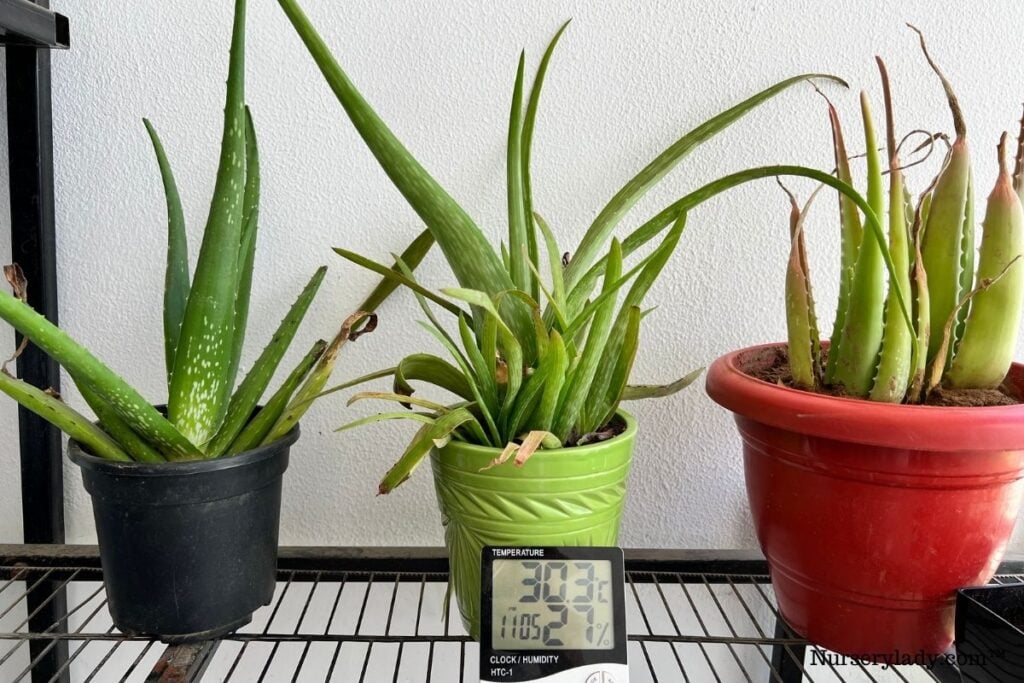
Belonging to warm areas, Aloes grow best when the temperature stays between 55 and 75°F.
If they are indoors, keep them in a room with such temperatures.
This temperature is available mainly indoors.
That is why most people grow them indoors.
If you want to keep them outdoors, make sure your region receives such temperatures all the time.
If not, you can still keep them outdoors, but in containers.
If the temperature becomes unfavorable, you can easily change their location.
If the temperature exceeds 80-90°F, they will go dormant.
Take care of outdoor Aloe Veras during such time, reduce watering, protect them from harsh temperatures, and don’t fertilize.
In most cases, gardeners recommend stopping watering.
But hydration is necessary.
So, you can water them in small quantities once a month.
Don’t forget to check the soil before watering.
Also read: Can Aloe Vera Plants Survive Cold Weather? (+Deal With Cold Damage)
10. Aloes cannot withstand cold temperatures.
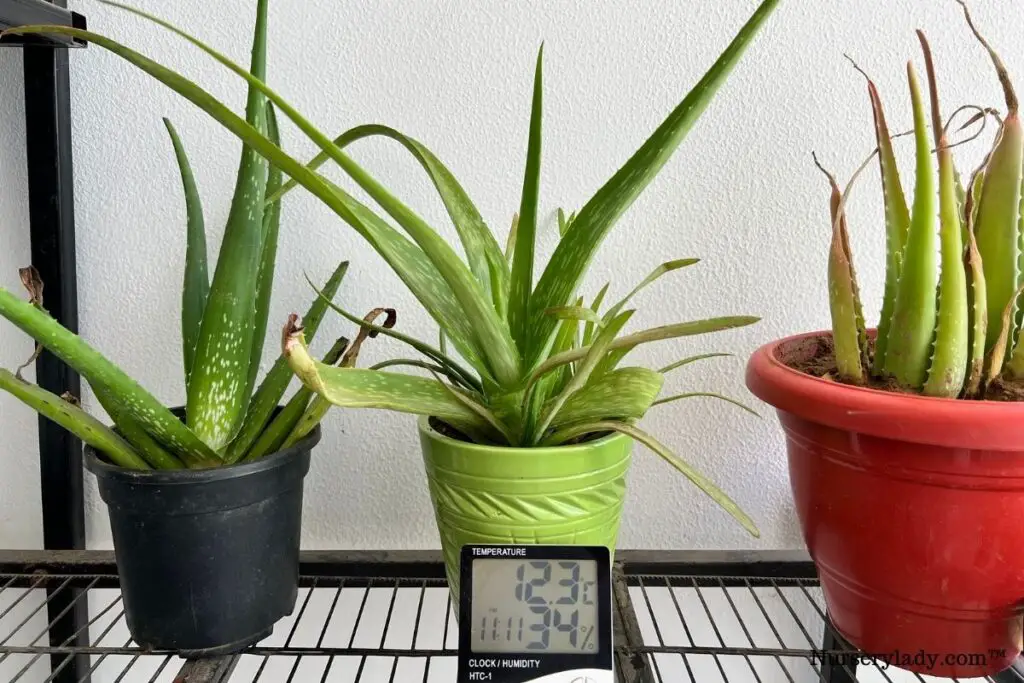
It will cause frost and freeze damage, and these damages can kill the plant.
If the temperature in your area receives low temperatures below 55°F and frost, grow Aloes in containers to bring them inside during the cool autumn.
Fix frost clothes for outdoor Aloes to prevent the frost from touching them.
Stop watering for some weeks and add some small pebbles to the soil surface.
It keeps the soil warm and stops the cold from reaching the roots.
It also reduces evaporation and keeps the soil moist.
Thus, a pause in watering will be fine.
Make sure it receives direct sunlight throughout the day.
It will keep them warm.
Fix frost cloths when the sun goes down.
For indoor aloes, avoid bathrooms and kitchen.
Ignore locations close to air conditioners, heaters, radiators, and aquariums.
Also read: Aloe Vera Temperature Tolerance: Ideal Temperature+Keeping Them Safe
11. Maintain low humidity

Since Aloes belong to arid areas, they can tolerate dry air around them.
High humidity increases their moisture level and again can cause overwatering, root rot, and other fungal diseases.
The humidity around the Aloes must remain within 30-50%.
Though they won’t mind if it is less, that’s unnecessary.
Additionally, extremely low humidity forces the moisture to lose faster, thus dehydrating the plant.
But it should not go beyond 50%.
Also read: Do Aloe Vera Like Humidity? (Ideal Humidity+How To Maintain)
12. Repot the Aloe Veras once every 1-2 years
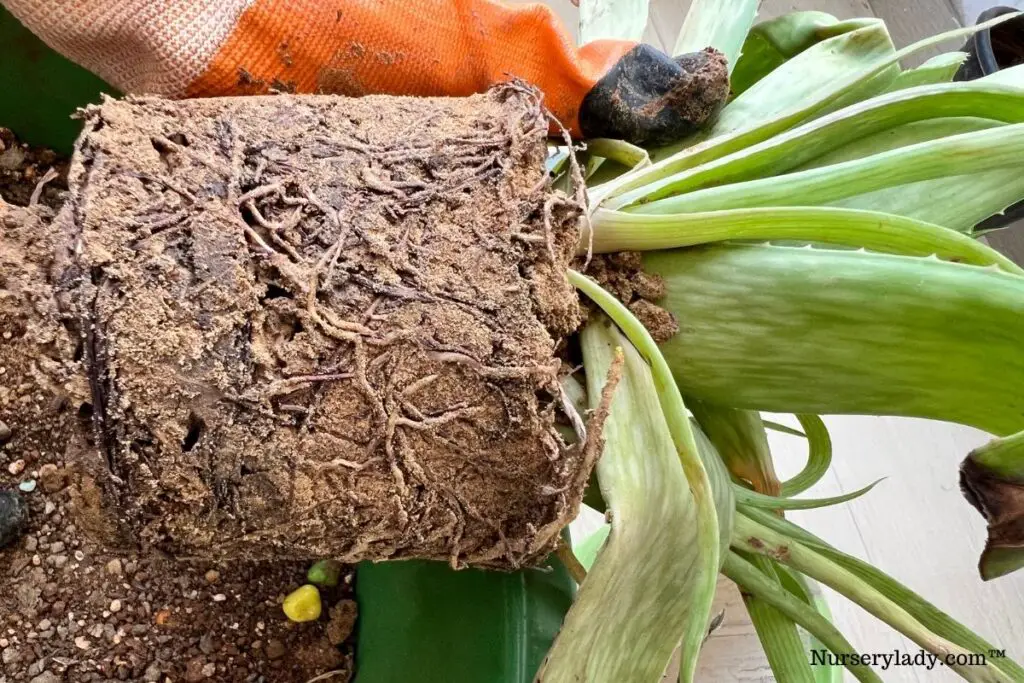
Aloes grow fast outside. So, you can repot them every 1-2 years.
But, it is diverse for indoor Aloes. Indoor Aloes take 3-4 years to reach 8-10 inches.
So, increase the time gap of repotting for the indoor Aloe Veras.
Follow the signs of root-bound or overcrowding as a beginner whenever you think of repotting.
When the roots grow out of the potholes or the planter looks swelled due to excess roots and pups, repot the Aloes.
Fast or late, never forget to repot the Aloes.
It gives more space to grow roots and pups without any suffocation.
Remember not to repot them too often.
That can shock the plant while they are still trying to adjust to their new home.
Always repot them during the spring. As it is their growing months, they can fight and recover shocks faster and begin energetic growth.
Also read: Does Aloe Vera Plant Like To Be Root Bound? (Possible Problems+Repot)
13. Propagate the Aloe Veras to get more new plants.
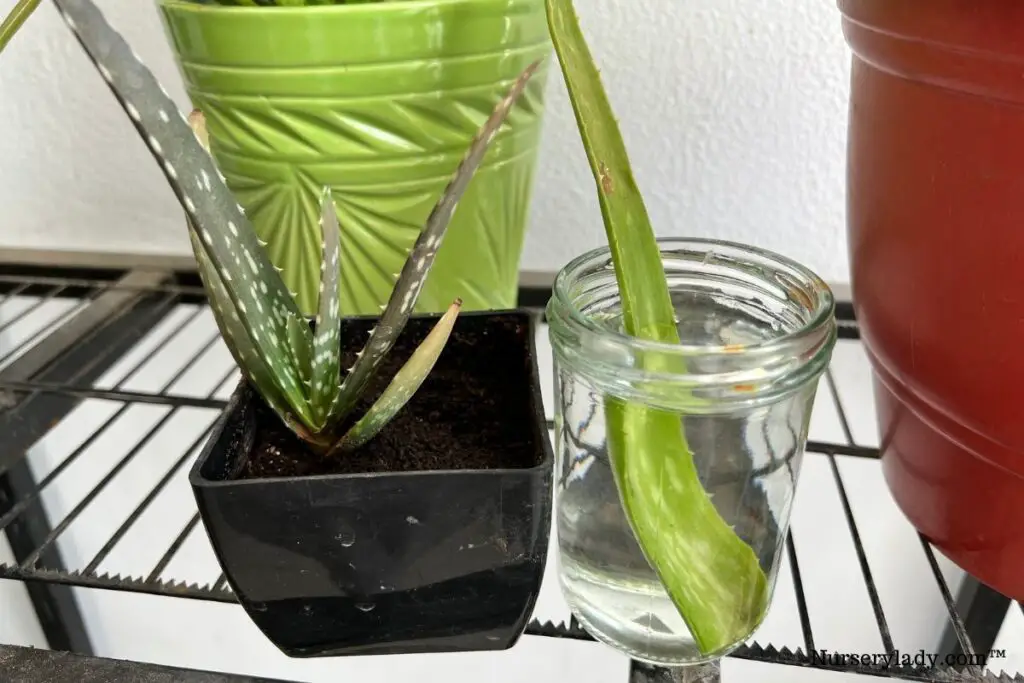
The best time to propagate Aloe is spring because they will grow vigorously.
Aloes are propagated in various ways – offsets, leaf cuttings, and seeds.
Only offset propagation show positive results in water propagation.
Offset propagation is one of the easiest and most successful methods.
Find the offsets that are 1/4th or 1/5th the size of the mother plant.
Separate them and plant them in a new container with well-drained soil.
Water them after some days in little amounts.
Don’t expose them to direct sunlight unless they have established.
For leaf cuttings, choose the healthy mature leaves.
Cut them close to the stem and let them heal for some days.
Also, spread some fungicide over them to avoid any fungus development.
Direct planting without healing can rot the leaves.
When the cut portion has hardened, dip the cut end into rooting hormone and plant them in well-drained soil.
Water them slightly to maintain enough moisture.
Let them have indirect sunlight until established.
You will find new root growth within a few weeks.
You can try water propagation with leaves.
But they may shrivel and die.
So, soil propagation has a higher possibility of success.
For seed propagation, wait for the plant to flower or get them online.
Collect the seeds from the seedpods, and store them in an envelope in a cool and dark place.
Sow them within a year.
Spread the seeds evenly in well-drained soil and cover them with another thin layer of soil.
Mist the soil to moisten it and place them in a warm location. Don’t expose them to the direct sun.
Check the moisture level daily and moist it whenever required.
Propagation is also possible through rhizome and stem cutting.
For more information, visit the propagation article where I have explained the propagation of Aloe Veras in detail.
Also read: How To Propagate Aloe Vera Plant? (Step-by-Step Guide)
14. You can encourage the Aloes to bloom.
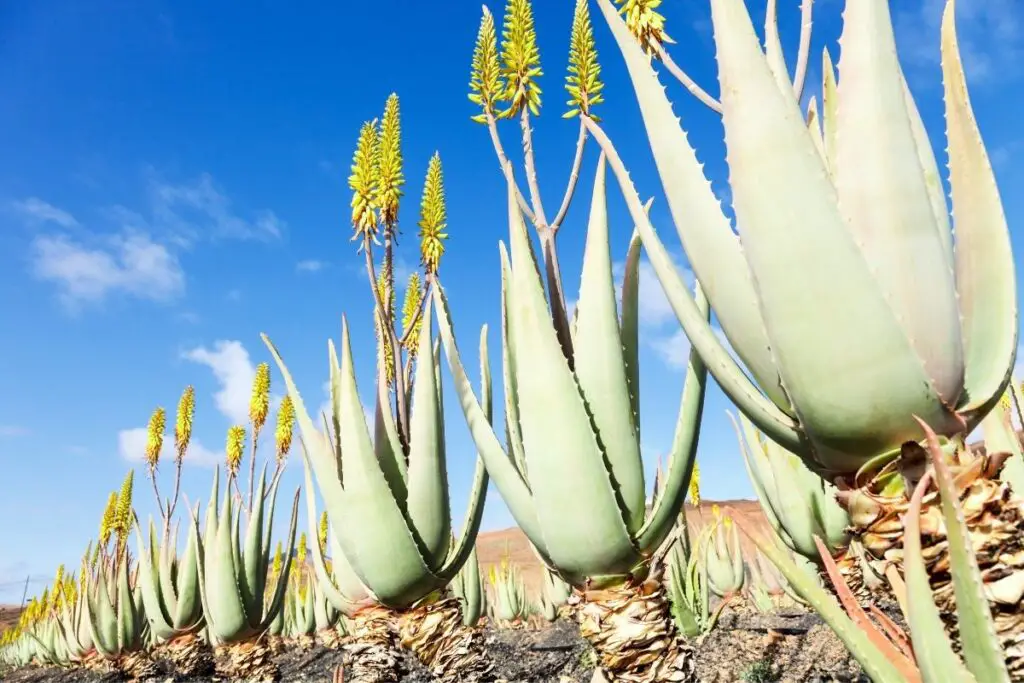
Yes, Aloes bloom once annually, from early spring to summer.
However, the time will differ depending on the zones and hemispheres.
For example, Aloes will grow buds in winter and bloom in the early spring in the northern hemisphere.
Aloes will only bloom if they are outdoors and are four years old.
Young ones won’t flower.
Since the outdoor Aloes can participate in pollination, they will bloom without fail.
For indoor Aloes, you need to force them for it.
Indoor Aloes generally bloom in winters.
Once the flower dies, remove the dead bloom.
It will stop them from absorbing all the nutrients, keep the plant healthy and encourage new flowers.
For letting them bloom, follow all the care tips I have shared till now.
These tips will not only keep the Aloes healthy but will also encourage blooming.
Your garden will look amazing with its flowers.
15. Aloes should remain out of the reach of children and pets.
The latex of the Aloe Vera is dangerous to both humans and animals.
It contains saponin, a group of molecules that bonds the sugar content.
A true Aloe Vera plant, also called Aloe Barbadensis, contains poisonous toxins like anthracene, glycosides, and anthraquinones.
If ingested, it causes muscle cramps, diarrhea, nausea, breakdown of red blood cells, and dehydration.
It also reduces blood pressure.
Consequences are coma and death.
The percentage of toxicity depends on how much quantity is consumed.
If a little amount is ingested, treatment will be easy and quickly recover.
If ingested in large amounts, it will take time. The pet or the human will suffer for some days.
However, the gel is not harmful.
It is safe and can be used for treating wounds and burns.
Even if the pets lick them accidentally, nothing will happen.
Also read: Does An Aloe Vera Plant Bloom? (When, How & More)
Final thoughts
Aloes are easy-to-grow plants, and they won’t bother you with excess demands. They will easily thrive even on neglect. Despite this fact, you should let them have some fundamental care tips to let them flourish.
Maintain enough sunlight, scarce watering, occasional fertilization, warm temperature, low humidity, and well-drained soil.
Repot the Aloes every 1-2 years and increase the gap for indoor plants. Propagate to get more Aloes and keep them away from pets and children.
Reference: NCBI, New York Botanical Garden, University of New Hampshire, University of Florida, Wikipedia.
